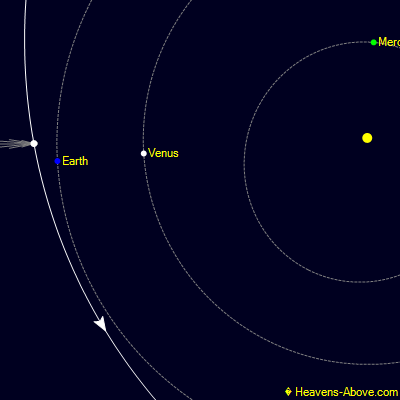|
Sometimes "CSI enhance" really works, just not with blurry CCTV footage of hardened criminals. The biggest obstacle to taking clear images of the Moon and planets is Earth's turbulent atmosphere, which causes a heat -haze like effect. Astronomers use a technique called lucky imaging to overcome this. A video is taken of the target and stacking software used to identify and combine the sharpest frames. This makes it possible to recover detail impossible to see in the source video or at the eyepiece.
The image above was taken with a 12" dobsonian telescope with a 2x barlow lens, giving an effective focal length of 3,000mm. For comparison, a very large telephoto lens might have a focal length of 600mm, one fifth the magnification. AutoStakkert 3.1.4 was used to analyse and stack the source video. As well as the atmospheric turbulence it was able to cope with some uneven motion from the telescope as it tracked the target crater imperfectly. So why doesn't technique this work with CCTV footage? If the subject stays quite still it is possible to recover a bit more detail by combining frames, but this won't work if they are moving. Also, the quality of any image is constrained by the size and quality of the optics, and the image sensor. A small lens and cheap sensor produces images with limited resolution even under the best conditions. Copernicus crater, on the near side of the Moon, is 93km across and 3.8km deep - not quite big enough to fit the county of Cornwall inside it. It's a relatively young crater, thought to have excavated by an impact some 800 million years ago. It's surrounded by a visible system of rays pointing outwards, lighter materiel that was ejected and that still lies on the Moon's surface. The best place to photograph it is from Lunar orbit rather than the surface of the Earth, 360,000km away, but that's not an option for most astronomers. These two spectacular images were taken during the Apollo 12 mission.
0 Comments
Here's a view of the Kit Hill chimney stack taken from almost 6 miles away, taken with a cheap telescope and an old webcam. On the whole it's a fair representation of what can be seen through the eyepiece. Colours are a little washed out because Kit Hill was in shadow but it's just possible to make out people walking around the stack. However, the static image doesn't show the 'heat haze' effect caused by moving currents of air, the eyepiece view isn't as sharp. Jupiter has been pasted in at the same image scale as the close up. Jupiter's apparent size varies depending on where it and Earth are in their orbits around the Sun. Even at its closest approach (628 million kilometres) Jupiter's angular size is only 50 arc-seconds or 0.014 degrees. Photographing Jupiter is like taking a picture of a 5 pence piece from 320 feet away. (But while high magnification is required to see the planets, some nebulae cover surprisingly large patches of sky.)  The full-size image of Jupiter shows more detail. The major cloud bands are visible and the great red spot, a giant storm at least 300 years old, is at lower right. The dark mark is the shadow of one of Jupiter's moons. This image was taken using a different telescope, a 5" refractor, and a 4x magnifying Barlow lens. This combination gives about 3.6 times the magnification of the telescope in the top image, when used with the same camera. To image the planets and Moon amateurs use a technique called 'lucky imaging', to overcome distortion caused by atmospheric turbulence. A short video is taken of the target and the clearest frames are selected and combined using free stacking software, such as Registax. For an example of amateur planetary imaging at its best I'd recommend taking a look at Damien Peach's website. Professional planetary imagers such as NASA either use the Hubble Space Telescope or simply park a spacecraft in orbit around their target, options beyond the budget of most amateurs. The Juno probe is currently at Jupiter and returning spectacular images. Going back to the telescope in the first image, a Celestron Astromaster 114, is not one I'd recommend. The telescope itself is useful but it's let down by the mount and finder, making it a frustrating business to find objects in the sky. Small Dobsonian telescopes are often recommend for people starting out in astronomy due to their low cost, ease of use and light grasp. They are a type of Newtonian telescope which use a mirror to gather and focus light. Compared to a pair of binoculars they are more stable and produce a brighter image. There are even cardboard self-assembly versions available.
Here's a quick animation from the night of 24th/25th March showing the movement of Comet 41P against the background stars. Each frame is a 2 minute exposure taken with a 135mm lens, the time-lapse is two hours long. On the 24th March it was visible in the bowl of The Big Dipper, or business end of The Plough if you prefer. The bright stars of this famous asterism are just out of frame. Over the next few days it moved into the neighbouring constellation of Draco. Comet 41P goes by the name of Tuttle–Giacobini–Kresák which is a bit of a mouthful. This is because comets are typically named after their discoverers, 41P was independently found in 1858, 1907 and 1951. It is a short period comet which approaches the Sun every 50 years or so and is thought to have a nucleus about a mile across. The comet has a circular appearance rather than showing the classic cometary tail because of the viewing angle.
... |
Archives
May 2020
Categories
All
|








 RSS Feed
RSS Feed